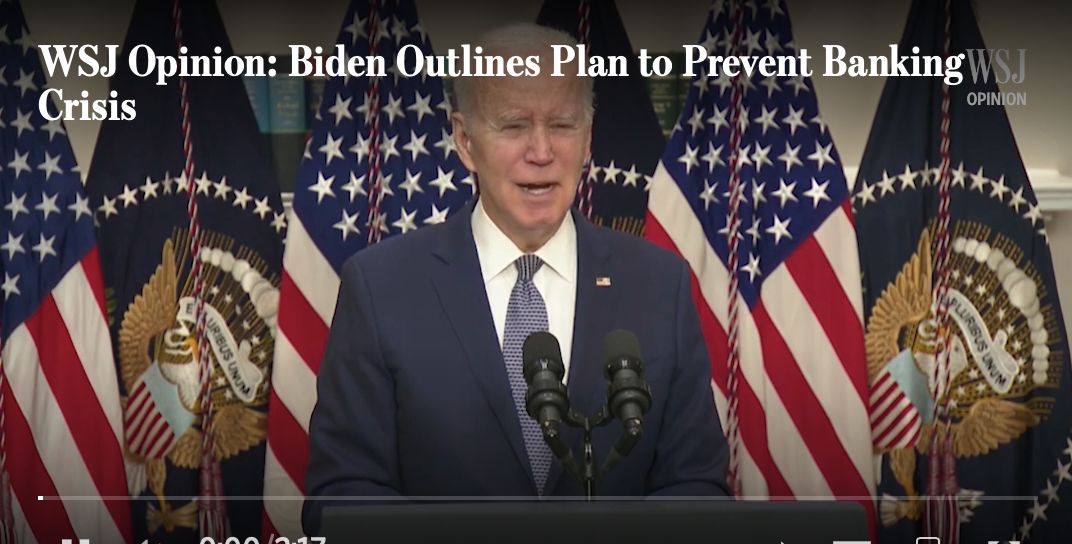By
Perhaps investors don’t believe the Administration’s Sunday interventions solve the problems. The Federal Deposit Insurance Corp. says it couldn’t find a private buyer for SVB, though a source tells us Treasury and the Federal Reserve favored one. FDIC Chairman Martin Gruenberg nixed it owing to hostility to bank mergers.
Instead the regulators offered solutions that bail out even uninsured bank depositors and other banks at unknown costs that Mr. Biden isn’t acknowledging. Take Mr. Biden’s pledge that “no losses will be borne by the taxpayers.” He said “the money will come from the fees that banks pay into the Deposit Insurance Fund.”
***
That’s not nearly the full story. The FDIC’s Deposit Insurance Fund normally guarantees up to $250,000 in deposits, which protects small retail customers including mom-and-pop businesses. Banks pay for this guarantee with insurance premiums, but the insurance fund isn’t intended to backstop deposits of bigger customers with more capacity to weather losses if a bank goes under.
Yet after venture capitalists (Democratic donors) and Silicon Valley politicians howled, the FDIC on Sunday announced it would cover uninsured deposits at SVB and Signature Bank under its “systemic risk” exception. Apparently, Silicon Valley investors and startups are too big to lose money when they take risks. They benefited enormously from the Fed’s pandemic liquidity hose, which caused SVB’s deposits to double between 2020 and 2021. SVB paid interest of up to 5.28% on large deposits, which it used to fund loans to startups.
But now the FDIC is guaranteeing a risk-free return for startups and their investors. Uninsured deposits normally take a 10% to 15% hair cut during a bank failure. Some 85% to 90% of SVB’s $173 billion in deposits are uninsured. The cost of this guarantee could be $15 billion.
The White House says special assessments will be levied on banks to recoup these losses. That means bank customers with less than $250,000 in deposits will indirectly pay for this through higher bank fees. In other words, this is an income transfer from average Americans to deep-pocketed investors.
Mr. Biden also claimed “investors in the banks will not be protected. They knowingly took a risk and when the risk didn’t pay off, investors lose their money. That’s how capitalism works.” Yes, ordinarily. But the Federal Reserve’s new emergency lending facility will ensure banks don’t have to take losses liquidating their bonds to meet deposit redemptions.
Many banks have hedged their interest-rate risk and diversified their deposits, which comes at a business cost, but some like SVB and Signature didn’t. The Fed is now saying that’s OK—we’ve got your back.
As he so often does, the President also blamed the bank panic on the Trump Administration—in this case for modifying some 2010 Dodd-Frank Act rules. He seems to be referring to the 2018 bipartisan banking law, which raised the threshold for systemically important financial institution (Sifi) classification to $250 billion from $50 billion in assets.
But not even Barney Frank, the Dodd-Frank co-author, believes that is to blame (see nearby). The point of the 2018 law was to ease costly compliance burdens on mid-sized banks that made them less competitive with the giants, which benefit from a lower cost of funding owing to their implicit government backstop. Excessive Dodd-Frank regulation was driving more deposits to big banks.
Before the 2018 law, most mid-sized banks had to comply with the same regulations as big banks. But these wouldn’t have prevented either bank’s failure from their risk-management mistakes. The 2018 law didn’t absolve mid-sized banks of the requirement to conduct quarterly liquidity stress tests to ensure they could weather “adverse market conditions” and “combined market and idiosyncratic stresses” such as interest-rate shocks.
They also must hold a liquidity buffer of “highly liquid assets” such as Treasurys and government agency mortgage-backed securities. Dodd-Frank encouraged banks to load up on these assets, which were especially sensitive to the rapid rise in interest rates. Yet somehow regulators failed to monitor this interest-rate duration risk.
***
The biggest surprise Monday is that the new deposit guarantees and Fed liquidity facility didn’t do more to calm markets. Perhaps investors suspect the problems on bank balance sheets or income statements run deeper than jittery depositors. Or perhaps they see an emboldened FDIC looking for vulnerable balance sheets or disapproved business models like Signature’s crypto focus to shut down.
They may also see a White House whose first instinct, even in a financial panic, is to spin reality and hunt for political scapegoats. None of this will restore confidence, which is what’s really needed in a panic.
To see this article in its entirety and subscribe to others like it, choose to read more.
 Listen Online
Listen Online Watch Online
Watch Online Find a Station in Your Area
Find a Station in Your Area







 Listen Now
Listen Now Watch Online
Watch Online
